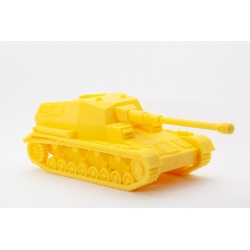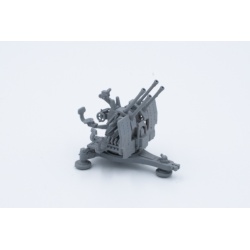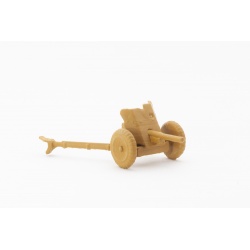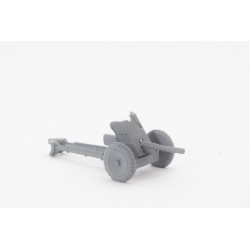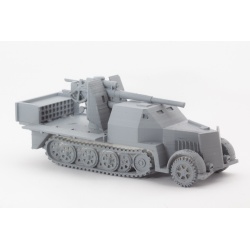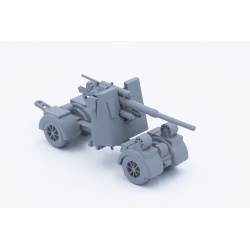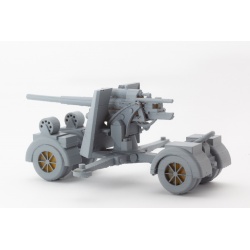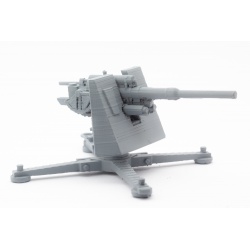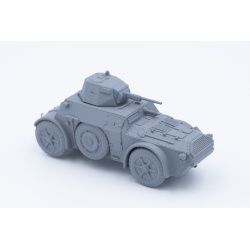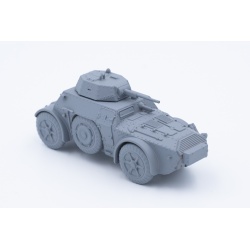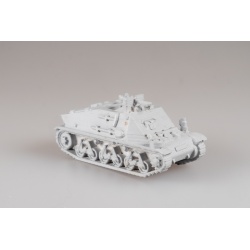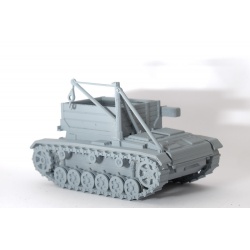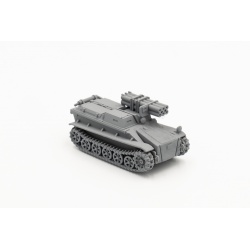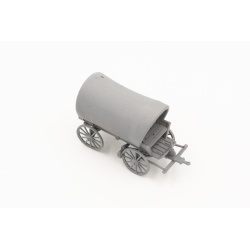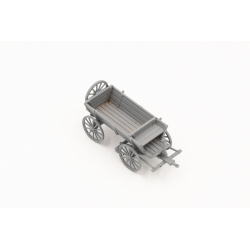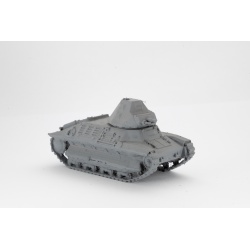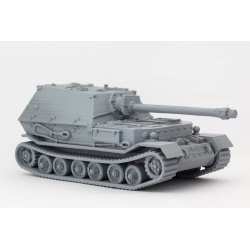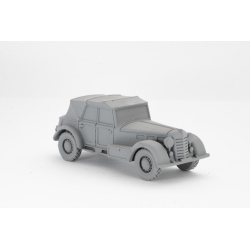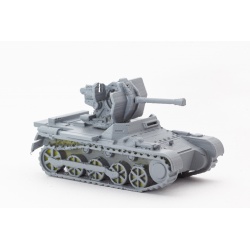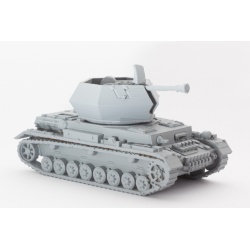Germany
10.5 cm K gepanzerte Selbstfahrlafette
Model comes in three parts; Hull and Tracks.
The Dicker Max was a German prototype self-propelled gun designed as a bunker buster for the Maginot Line in France.
It was built on a Pz.Kpfw IV E chassis and featured a 20.cm schwere Kanone 18 gun.
Only 2 models were built. They saw action in Russia with the Panzerjager Abteilung 521. One was destroyed by fire after flames spread to the ammunition and it exploded. The other fought into 1942.
The Dicker Max was a German prototype self-propelled gun designed as a bunker buster for the Maginot Line in France.
It was built on a Pz.Kpfw IV E chassis and featured a 20.cm schwere Kanone 18 gun.
Only 2 models were built. They saw action in Russia with the Panzerjager Abteilung 521. One was destroyed by fire after flames spread to the ammunition and it exploded. The other fought into 1942.
Dicker Max
2cm Flakvierling 38
Model comes in two parts; gun and stand (resin).
The 2cm Falkvierling 38 entered service in 1940. It was made of four 2cm anti aircraft guns, two on each side. It could fire up to 1800 rounds per minute.
It was mounted on the Sd.Kfz. 7/1 of which between 750 and 800 were built between 1940 and 1944.
Note: (Model is only available as a resin print)
The 2cm Falkvierling 38 entered service in 1940. It was made of four 2cm anti aircraft guns, two on each side. It could fire up to 1800 rounds per minute.
It was mounted on the Sd.Kfz. 7/1 of which between 750 and 800 were built between 1940 and 1944.
Note: (Model is only available as a resin print)
German Anti-aircraft Gun
3.7cm Pak 36
Model comes as one part.
The Pak 36 is a 3.7cm anti-tank gun.
It was used between 1936 and 1945. Germany had just over 9,000 Pak 36s at the start of the war and made another 5,339 during the war.
It had a crew of 5; commander, gunner, loader and 2 ammunition carriers.
The Pak 36 is a 3.7cm anti-tank gun.
It was used between 1936 and 1945. Germany had just over 9,000 Pak 36s at the start of the war and made another 5,339 during the war.
It had a crew of 5; commander, gunner, loader and 2 ammunition carriers.
Panzerabwehrkanone 36
3.7cm Pak 36 (limbered)
Model comes as one part.
The Pak 36 is a 3.7cm anti-tank gun.
It was used between 1936 and 1945. Germany had just over 9,000 Pak 36s at the start of the war and made another 5,339 during the war.
It had a crew of 5; commander, gunner, loader and 2 ammunition carriers.
This is the limbered version for towing.
The Pak 36 is a 3.7cm anti-tank gun.
It was used between 1936 and 1945. Germany had just over 9,000 Pak 36s at the start of the war and made another 5,339 during the war.
It had a crew of 5; commander, gunner, loader and 2 ammunition carriers.
This is the limbered version for towing.
Panzerabwehrkanone 36
8.8 cm Flak 18 (Sfl.) auf Zugkraftwagen
Model comes as two parts: Truck and Gun.
Ar the start of the war 10 Sd.Kfz 8 & 9s were altered to carry the 8.8cm Flak. The cab replaced with armour. It was also known as the Bunkerflak.
The vehicles saw action in the invasion of Poland and France an Operation Barbarossa. It weighed 20 tons.
Ar the start of the war 10 Sd.Kfz 8 & 9s were altered to carry the 8.8cm Flak. The cab replaced with armour. It was also known as the Bunkerflak.
The vehicles saw action in the invasion of Poland and France an Operation Barbarossa. It weighed 20 tons.
Flakbus
8.8cm Flak 36 (carriage stowed)
Model comes in two parts, gun and carriage (resin)
The 88mm Flak 36 is one of the most widely recognised weapons of World War II and was in service between 1936 and 1945. Over 21,000 units were produced.
It could be used as both anti-aircraft and anti-tank artillery and could fire 18 to 20 rounds per minute. It had a range of almost 10km or a ceiling of 35,000 ft.
The gun had a crew of 10.
This model comes on wheeled gun carriage. The gun can be rotated or removed from the carriage. The side legs of the carriage are in the stowed position.
Note: (Model is only available as a resin print)
The 88mm Flak 36 is one of the most widely recognised weapons of World War II and was in service between 1936 and 1945. Over 21,000 units were produced.
It could be used as both anti-aircraft and anti-tank artillery and could fire 18 to 20 rounds per minute. It had a range of almost 10km or a ceiling of 35,000 ft.
The gun had a crew of 10.
This model comes on wheeled gun carriage. The gun can be rotated or removed from the carriage. The side legs of the carriage are in the stowed position.
Note: (Model is only available as a resin print)
German Artillery
8.8cm Flak 36 (carriage)
Model comes in two parts, gun and emplacement.
The 88mm Flak 36 is one of the most widely recognised weapons of World War II and was in service between 1936 and 1945. Over 21,000 units were produced.
It could be used as both anti-aircraft and anti-tank artillery and could fire 18 to 20 rounds per minute. It had a range of almost 10km or a ceiling of 35,000 ft.
The gun had a crew of 10.
This model comes on wheeled gun carriage. The gun can be rotated or removed from the carriage.
The 88mm Flak 36 is one of the most widely recognised weapons of World War II and was in service between 1936 and 1945. Over 21,000 units were produced.
It could be used as both anti-aircraft and anti-tank artillery and could fire 18 to 20 rounds per minute. It had a range of almost 10km or a ceiling of 35,000 ft.
The gun had a crew of 10.
This model comes on wheeled gun carriage. The gun can be rotated or removed from the carriage.
on gun carriage
8.8cm Flak 36 (emplacement)
Model comes in two parts, gun and emplacement.
The 88mm Flak 36 is one of the most widely recognised weapons of World War II and was in service between 1936 and 1945. Over 21,000 units were produced.
It could be used as both anti-aircraft and anti-tank artillery and could fire 18 to 20 rounds per minute. It had a range of almost 10km or a ceiling of 35,000 ft.
The gun had a crew of 10.
This model comes on the static emplacement. The gun can be rotated or removed from the emplacement.
The 88mm Flak 36 is one of the most widely recognised weapons of World War II and was in service between 1936 and 1945. Over 21,000 units were produced.
It could be used as both anti-aircraft and anti-tank artillery and could fire 18 to 20 rounds per minute. It had a range of almost 10km or a ceiling of 35,000 ft.
The gun had a crew of 10.
This model comes on the static emplacement. The gun can be rotated or removed from the emplacement.
on emplacement
Autoblinda 41
Model comes in two parts; body & turret (resin).
The Autoblinda was an Italian armoured car manufactured by Fiat-Ansaldo between 1941 & 1943. It came in three versions, 40, 41 & 43, named after the year of production.
Most versions were armed with a 35mm Breda 20mm autocannon and an 8mm coaxial machine gun.
Some 550 of all versions were built and they were used by Italy & Germany.
Note: (Model is only available as a resin print)
The Autoblinda was an Italian armoured car manufactured by Fiat-Ansaldo between 1941 & 1943. It came in three versions, 40, 41 & 43, named after the year of production.
Most versions were armed with a 35mm Breda 20mm autocannon and an 8mm coaxial machine gun.
Some 550 of all versions were built and they were used by Italy & Germany.
Note: (Model is only available as a resin print)
Italian Armoured Car
Autoblinda 43 (v2)
Model comes in two parts; body & turret (resin).
The Autoblinda was an Italian armoured car manufactured by Fiat-Ansaldo between 1941 & 1943. It came in three versions, 40, 41 & 43, named after the year of production.
Most versions were armed with a 35mm Breda 20mm autocannon and an 8mm coaxial machine gun.
Some 550 of all versions were built and they were used by Italy & Germany.
Note: (Model is only available as a resin print)
The Autoblinda was an Italian armoured car manufactured by Fiat-Ansaldo between 1941 & 1943. It came in three versions, 40, 41 & 43, named after the year of production.
Most versions were armed with a 35mm Breda 20mm autocannon and an 8mm coaxial machine gun.
Some 550 of all versions were built and they were used by Italy & Germany.
Note: (Model is only available as a resin print)
Italian Armoured Car
Belehpanzer 38H(f)
Model comes as one part.
The German army captured and used many French armoured vehicles during the early part of the war.
This is a Hotchkiss 38 converted for use as an observation tank by changing the superstructure.
The German army captured and used many French armoured vehicles during the early part of the war.
This is a Hotchkiss 38 converted for use as an observation tank by changing the superstructure.
German Observation Tank
Bergepanzer III
Model comes in 7 parts.
The Bergepanzer III was based on the Panzer III chassis. It was produced from March to December 1944. As the panzer IIIs were being withdrawn from service, 150 of them were converted into recovery vehicles.
The Bergepanzer III was based on the Panzer III chassis. It was produced from March to December 1944. As the panzer IIIs were being withdrawn from service, 150 of them were converted into recovery vehicles.
German Recovery Vehicle
Borgward IV Wanze
Model comes in 7 parts plastic, resin is 1 part
The Borgward Wanze was officially the ‘Schwerer Ladungsträger Borgward B IV’ which translates to ‘heavy explosive carrier Borgward B IV’.
The Borgward was the heaviest of the three remotely operated German WWII demolition vehicles.
Towards the end of the wear 56 Borgwards were converted into tank destroyers. They were called the Wanze (bug) and were equipped with six RPzB 54/1 anti-tank rockets.
Please note: Model photo is a resin print
The Borgward Wanze was officially the ‘Schwerer Ladungsträger Borgward B IV’ which translates to ‘heavy explosive carrier Borgward B IV’.
The Borgward was the heaviest of the three remotely operated German WWII demolition vehicles.
Towards the end of the wear 56 Borgwards were converted into tank destroyers. They were called the Wanze (bug) and were equipped with six RPzB 54/1 anti-tank rockets.
Please note: Model photo is a resin print
German Demolition Vehicle
Ersatz Feldwagen 43 (covered)
This model comes in two parts: body and front axle
The Feldwagen 43 (Hf.6) was a simple horse drawn wagon produced from 1943. As the war progressed and Germany lost more and more transport vehicles, so the Feldwagen became one of the most numerous forms of transport.
This is the covered version and please note the cover is not removable.
Model comes in resin only
The Feldwagen 43 (Hf.6) was a simple horse drawn wagon produced from 1943. As the war progressed and Germany lost more and more transport vehicles, so the Feldwagen became one of the most numerous forms of transport.
This is the covered version and please note the cover is not removable.
Model comes in resin only
German Wagon
Ersatz Feldwagen 43 (open)
This model comes in two parts: body and front axle
The Feldwagen 43 (Hf.6) was a simple horse drawn wagon produced from 1943. As the war progressed and Germany lost more and more transport vehicles, so the Feldwagen became one of the most numerous forms of transport.
This is the open version without cover.
Model comes in resin only
The Feldwagen 43 (Hf.6) was a simple horse drawn wagon produced from 1943. As the war progressed and Germany lost more and more transport vehicles, so the Feldwagen became one of the most numerous forms of transport.
This is the open version without cover.
Model comes in resin only
German Wagon
FCM 36
Model comes in 2 parts, hull & turret.
The FCM 36 was French Light Infantry Tank. 100 models were built between 1938 and 1939.
It was fitted with a 37mm L/21 DSA18 gun and a 7.5mm MAC31 Reibel machine gun.
37 models were captured and used by the Germans under the designation Panzerkampfwagen 737 FCM (f).
The FCM 36 was French Light Infantry Tank. 100 models were built between 1938 and 1939.
It was fitted with a 37mm L/21 DSA18 gun and a 7.5mm MAC31 Reibel machine gun.
37 models were captured and used by the Germans under the designation Panzerkampfwagen 737 FCM (f).
Char léger Modèle 1936 FCM
Fiat 2800 CMC
Model comes in 9 parts.
The Fiat 2800 was a 4-door saloon produced between 1938 and 1944. The CMCV was introduced for military service in 1939.
Please note the photos provided are of the resin print.
The Fiat 2800 was a 4-door saloon produced between 1938 and 1944. The CMCV was introduced for military service in 1939.
Please note the photos provided are of the resin print.
Italian Command Car
Flakpanzer i
Model comes in two parts; hull and gun.
The Panzer I was designed in 1932 and went into production in 1934. It saw action in the Spanish Civil War, in WWII in Poland, France, Russia and North Africa.
The Flakpanzer was based on a Pz.Kpfw I Ausf A chassis which had a 2cm Flak 38 anti-aircraft gun mounted on it.
Around 24 models were built. It had a crew of 4 and weighed 5.5 tons.
The Panzer I was designed in 1932 and went into production in 1934. It saw action in the Spanish Civil War, in WWII in Poland, France, Russia and North Africa.
The Flakpanzer was based on a Pz.Kpfw I Ausf A chassis which had a 2cm Flak 38 anti-aircraft gun mounted on it.
Around 24 models were built. It had a crew of 4 and weighed 5.5 tons.
2 cm Flak 38 auf Panzer I Ausführung A
Flakpanzer IV Ostwind
Model comes in three parts; Hull, Gun & Turret.
The Ostwind - East Wind - was a self propelled anti aircraft gun based on the Panzer IV chassis.
The Pz IV turret was removed and replaced with a 3.7cm Flak 43 gun in an octagonal turret. It also had a 7.92mm MG 34 machine gun.
44 Ostwinds were produced between 1944 and 1945, though only 7 were brand new, the rest were converted Pz IVs.
It weighed 25 tonnes and had a crew of five; Commander, Gunner, Loader, Driver and Radio Operator.
The Ostwind - East Wind - was a self propelled anti aircraft gun based on the Panzer IV chassis.
The Pz IV turret was removed and replaced with a 3.7cm Flak 43 gun in an octagonal turret. It also had a 7.92mm MG 34 machine gun.
44 Ostwinds were produced between 1944 and 1945, though only 7 were brand new, the rest were converted Pz IVs.
It weighed 25 tonnes and had a crew of five; Commander, Gunner, Loader, Driver and Radio Operator.
Flak 43


